

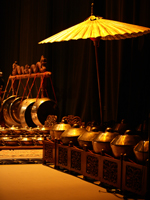
Gamelan music is among the most well known of the hundreds of traditional performing art forms found within the cultures that make up the Republic of Indonesia. The word "gamelan" means percussion ensemble, and refers to a set of musical instruments from these islands. Gamelan instruments are made up of horizontally mounted and vertically hanging metal gongs, metal xylophones of varying sizes, flutes, drums, bowed lute, zithers, and singers. Similar ensembles exist throughout Southeast Asia (such as piphat in Thailand or kulingtang in the Philippines.
Ideally, the metal used for gamelan instruments is bronze, but many are made of iron; wood and bamboo are other main materials used.
Each gamelan exhibits its own unique tuning within certain norms, and this contributes to a special individual character which warrants a proper name for each gamelan. The name of a gamelan is based on its quality of sound as well as philosophical considerations, and is often presented in a naming ceremony.
Consequently, the instruments of one gamelan generally cannot be interchanged with those of another, since each set is quite distinctive in the nuances of its tuning.
Gamelan music operates on the principle of cyclic time, as opposed to the linear time that underlies Western music.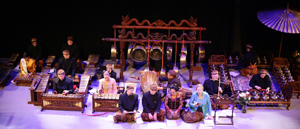 For this reason, there is no definite duration for any gamelan piece, the cycles of a composition may be repeated as many times as the situation requires.
The biggest gong in the ensemble is used to mark the end of a cycle, which is also the beginning. The basis for gamelan music is structured by layering five or six separate but related musical lines, all based on a central core melody, that are either ornamented by faster moving notes or simply provide periodic punctuation.
This results in a rich, elaborate interlocking, multitiered, texture.
For this reason, there is no definite duration for any gamelan piece, the cycles of a composition may be repeated as many times as the situation requires.
The biggest gong in the ensemble is used to mark the end of a cycle, which is also the beginning. The basis for gamelan music is structured by layering five or six separate but related musical lines, all based on a central core melody, that are either ornamented by faster moving notes or simply provide periodic punctuation.
This results in a rich, elaborate interlocking, multitiered, texture.
The ensemble does not rely on a single visible conductor. Rather, changes in tempo and dynamics are controlled by audible drum signals, while formal elements are controlled by signals that are passed between various melodic instruments. In certain dances pieces, the dancer leads, giving split-second cues to the drummer, who then conveys them to the musicians. In fact, gamelan music can be characterized as music based on communal expression. The melody of a single instrument cannot be conceived as being separate from the sound as a whole, the feeling of unity, communality, or totality is based on the interaction and interrelationships among the instruments in the ensemble. This musical interdependence is perhaps the most important concept of gamelan music. While gamelan music can be enjoyed simply as music, it also accompanies theater, dance, and ritual. Indeed, in Java and Bali, almost any performance is usually part of a larger ritual function to celebrate an important life-cycle milestone, or calendrical event. Some examples would be the birth of a child, coming of age ceremony, wedding, funeral, harvest, temple ceremonies, and the like. In traditional Balinese and Javanese culture, there is no clear separation between ritual and simple entertainment since every performance is a kind of spiritual offering. Thus, in many ways, playing and hearing gamelan music involves an aesthetics bound up in the spiritual � listening to and playing gamelan music, some say, is a form of meditation.
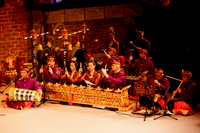
Bali has developed as many as 25-30 different types and sizes of gamelan ensembles throughout its history. Their sizes vary from a quartet of gender wayang (an ensemble to accompany shadow puppet theater), to an ensemble of forty musicians required to play for the Gamelan Gong Gede, a grand Balinese court orchestra.
The most modern Balinese gamelan orchestra is called Gamelan Gong Kebyar, which literally means "sudden burst". This ensemble appeared in the early part of this century, around 1914, and swiftly gained popularity over the older types of gamelan which played more stately musical styles.
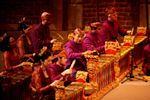 Various changes were made in the orchestra such as increasing the range of the instruments, permitting a more rapid playing style. Furthermore, Gamelan Gong Kebyar is rhythmically inventive, technically demanding, and notable for its dense contrapuntal textures, interlocking figuration, and frequent changes in dynamics and tempo.
Burat Wangi has two types of gamelan at its disposal, a Gamelan Gong Kebyar, and a Semar Pegulingan which is a courtly gamelan orchestra. Most of Burat Wangi's performances are accompanied by the Gamelan Gong Kebyar.
Various changes were made in the orchestra such as increasing the range of the instruments, permitting a more rapid playing style. Furthermore, Gamelan Gong Kebyar is rhythmically inventive, technically demanding, and notable for its dense contrapuntal textures, interlocking figuration, and frequent changes in dynamics and tempo.
Burat Wangi has two types of gamelan at its disposal, a Gamelan Gong Kebyar, and a Semar Pegulingan which is a courtly gamelan orchestra. Most of Burat Wangi's performances are accompanied by the Gamelan Gong Kebyar.
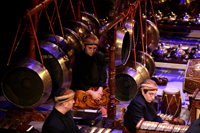
The Javanese culture is considered to have the most highly refined musical tradition of all the Indonesian islands, which numbers over 13,000.
A complete classical Javanese gamelan has two sets of instruments, one tuned to the five-tone slendro scale, and the other to the seven-tone pelog scale.
These two sets of instruments always have at least one common tone, and can be played together in certain instances.
Musical forms are defined by the rhythmic cycles. These consist of major cycles, sometimes as long as 64 beats, subdivided by smaller ones, each marked by the striking of successively smaller gongs.
A strike on the biggest gong in the ensemble, gong ageng, marks the end of a cycle, which is also the beginning. 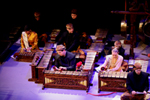 The melodic interplay takes place within this framework (technically called "colotomic").
There are also distinct melodic modes ("pathet") within the division of scale, three for each of the scales. The modes are defined according to which notes of the scale are emphasized.
The performing arts of the Javanese courts are refined and stately, and are often used to accompany meditation. This reflects a prevailing cultural concern for social politeness and personal emotional reserve. As opposed to some of the more rambunctious music and dance styles found in the thousands of neighboring regions.
This contrast is especially apparent between Javanese music and dance, and that of her little sister island of Bali, whose style is more dynamic and flashy. Both cultures harbor rich, beautiful, and very different performing arts styles, but both prioritize, emphasize, and honor the spiritual component of their artistic traditions.
The melodic interplay takes place within this framework (technically called "colotomic").
There are also distinct melodic modes ("pathet") within the division of scale, three for each of the scales. The modes are defined according to which notes of the scale are emphasized.
The performing arts of the Javanese courts are refined and stately, and are often used to accompany meditation. This reflects a prevailing cultural concern for social politeness and personal emotional reserve. As opposed to some of the more rambunctious music and dance styles found in the thousands of neighboring regions.
This contrast is especially apparent between Javanese music and dance, and that of her little sister island of Bali, whose style is more dynamic and flashy. Both cultures harbor rich, beautiful, and very different performing arts styles, but both prioritize, emphasize, and honor the spiritual component of their artistic traditions.